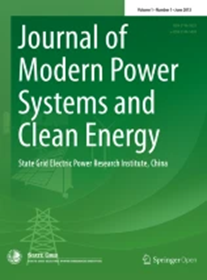基于变流器接口发电机的电厂网络重构感知功率振荡阻尼控制器
IF 6.1
1区 工程技术
Q1 ENGINEERING, ELECTRICAL & ELECTRONIC
Journal of Modern Power Systems and Clean Energy
Pub Date : 2025-03-11
DOI:10.35833/MPCE.2024.000057
引用次数: 0
摘要
近年来,输电系统运营商开始要求变流器接口发电机(CIGs)参与电力振荡阻尼(POD)等电网服务。由于电力系统容易因发电机和线路的连接和断开而发生拓扑变化,POD控制器设计中最重要的要求之一就是考虑这些变化。这可以通过在操作期间调整控制器结构或应用用于处理系统变化的固定结构来实现。固定结构通常是输电系统运营商的首选,因为它更容易确定其对系统的影响。本文提出了一种考虑任意一条线路断开时的网络配置的、具有网络重构意识的固定结构POD控制器的设计方法。设计过程基于频率响应技术,因此即使在没有详细的系统小信号模型的情况下,它也适用于基于cigs的发电厂。可以通过同时使用有功功率、无功功率或两种功率分量来设计用于系统关键模式阻尼的POD控制器。最后给出了该方法在连接IEEE 39总线系统的cigi电厂POD控制器设计中的应用实例。在MATLAB和SimPowerSystems中进行了仿真,验证了所提出的设计过程。验证包括对系统性能的分析,并考虑拟议设计过程中的变化。此外,研究了系统在未考虑的变化下的性能,包括负载和惯性值的变化,以及同步发电机的断开。本文章由计算机程序翻译,如有差异,请以英文原文为准。
Network-Reconfiguration-Aware Power Oscillation Damping Controller for Converter-Interfaced Generator Based Power Plants
In recent years, transmission system operators have started requesting converter-interfaced generators (CIGs) to participate in grid services such as power oscillation damping (POD). As power systems are prone to topology changes because of connection and disconnection of generators and lines, one of the most important requirements in the design of POD controller is to account for these changes. This can be done by either adjusting the controller structure during the operation or applying a fixed structure designed to address changes in the system. The fixed structure is usually preferred by transmission system operators since it is easier to determine its impact on the system. In this paper, a design procedure is proposed for network-reconfiguration-aware POD controller with fixed structure for CIG-based power plants that considers network configurations with any one line disconnected. The design procedure is based on frequency-response techniques, so it is suitable for application in CIG-based power plants, even in cases when a detailed small-signal model of the system is not available. Designs of a POD controller for the damping of critical system modes can be obtained by using active power, reactive power, or both power components simultaneously. The application to the design of a POD controller for a CIG-based power plant connected to the IEEE 39-bus system is presented as an example. Simulations performed in MATLAB and SimPowerSystems are used to validate the proposed design procedure. The validation includes an analysis of system performance with changes considered in the proposed designed procedure. Also, the system performance under unconsidered changes is examined, covering variations in load and inertia values, as well as disconnection of synchronous generators.
求助全文
通过发布文献求助,成功后即可免费获取论文全文。
去求助
来源期刊

Journal of Modern Power Systems and Clean Energy
ENGINEERING, ELECTRICAL & ELECTRONIC-
CiteScore
12.30
自引率
14.30%
发文量
97
审稿时长
13 weeks
期刊介绍:
Journal of Modern Power Systems and Clean Energy (MPCE), commencing from June, 2013, is a newly established, peer-reviewed and quarterly published journal in English. It is the first international power engineering journal originated in mainland China. MPCE publishes original papers, short letters and review articles in the field of modern power systems with focus on smart grid technology and renewable energy integration, etc.
 求助内容:
求助内容: 应助结果提醒方式:
应助结果提醒方式:


